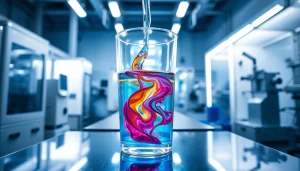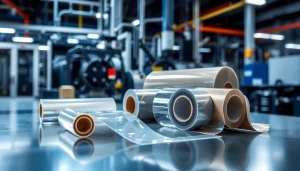Understanding Infusion Resins
Infusion resins play a critical role in the world of composite manufacturing, acting as the backbone of various modern applications. These specialized resins are designed for infusion processes, where they are drawn into a vacuum-sealed environment to saturate fibrous materials, leading to the creation of strong, lightweight structures. Whether in aerospace, marine, automotive, or construction sectors, the benefits and versatility of infusion resins are increasingly recognized.
What are Infusion Resins?
Infusion resins are low-viscosity polymer materials specifically engineered for the composite manufacturing process called infusion. This technique uses a vacuum to draw these resins into a pre-formed mold containing dry fibrous materials, such as fiberglass, aramid, or carbon fiber. The resulting product is often characterized by high strength, low weight, and superior durability, making it ideal for demanding applications.
Two primary types of infusion resins are commonly used: epoxy and polyester, each featuring unique properties that suit various applications. The infusion process not only minimizes waste but also ensures that the resin permeates every part of the fiber, maximizing the composite’s overall strength and performance.
Application Areas of Infusion Resins
The utility of infusion resins spans a wide range of industries due to their advantageous characteristics. Some notable applications include:
- Aerospace: Infusion resins are essential in constructing lightweight yet strong components such as wing structures and fuselage sections.
- Marine: Boat hulls and interior components benefit from the water-resistant and durable properties of infusion resins.
- Automotive: The automotive industry employs infusion resins to manufacture parts that improve fuel efficiency without sacrificing performance or safety.
- Construction: In civil engineering, infusion resins are used to create architectural elements that require both structural integrity and aesthetic appeal.
Benefits of Using Infusion Resins
Utilizing infusion resins presents several distinct advantages:
- High Strength-to-Weight Ratio: Infusion resins provide enhanced structural integrity while significantly reducing weight, which is critical in applications where performance is paramount.
- Reduced Waste: The infusion process relies on vacuum technology, which minimizes excess resin and makes for more environmentally friendly production methods.
- Optimized Material Flow: The low viscosity of infusion resins ensures even distribution and thorough saturation of fibers, leading to consistent quality in the final product.
- Flexibility in Design: Various custom formulations of infusion resins can be created to meet specific performance and aesthetic criteria.
Types of Infusion Resins
Epoxy Infusion Resins
Epoxy resins are renowned for their superior adhesion, flexibility, and chemical resistance. These characteristics make epoxy infusion resins the go-to choice for high-performance applications, especially in aerospace and motorsports. They typically exhibit low shrinkage during curing, resulting in minimal warping and deformation, which is essential for precise components. Furthermore, epoxy resins allow extensive customization and can incorporate additives to enhance specific properties, such as flame retardance or impact resistance.
Polyester Infusion Resins
Polyester infusion resins are commonly used due to their cost-effectiveness and relatively simple processing methods. Though they do not offer the same high strength levels as epoxies, they still provide adequate performance for many applications, particularly in the marine and automotive sectors. These resins cure quickly and can be easily colored, making them an appealing option for users looking for efficiency without extensive customization. However, polyester resins typically have a higher degree of odor and produce byproducts during curing, which must be managed properly.
Bio-Based Infusion Resins
With increasing emphasis on sustainability, bio-based infusion resins are gaining traction as a more environmentally friendly alternative. Derived from renewable resources, these resins aim to reduce carbon footprints without compromising performance. Despite being a newer entry in resin technology, advancements have quickly demonstrated their viability in high-performance applications, making them an exciting option for manufacturers targeting eco-conscious markets.
Choosing the Right Infusion Resins
Key Properties to Consider
When choosing infusion resins, it is vital to consider properties such as:
- Curing Time: The speed at which the resin cures can significantly impact production timelines and costs.
- Viscosity: Low viscosity is essential for proper infusion; it allows for better wet-out of fibers and minimizes the risk of dry spots.
- Temperature Resistance: Depending on the end application, the thermal performance of the resin may be a critical factor.
- Moisture Resistance: Certain applications require resistance to environmental conditions, making this property crucial for outdoor or high-humidity situations.
Comparative Analysis of Different Resins
Conducting a comparative analysis between resin types—epoxy, polyester, and bio-based—can provide valuable insights to inform the decision-making process. For instance, while epoxy resins offer superior strength and adhesion, they typically come at a higher price point than polyester resins. In contrast, polyester resins may be more affordable but may not perform as well under extreme conditions. Bio-based resins serve to bridge the gap, providing eco-friendly alternatives without drastically compromising performance.
Common Misconceptions about Infusion Resins
An understanding of infusion resins is often clouded by myths and misconceptions that can lead to suboptimal choices. Some common myths include:
- Cost: While it’s true some infusion resins can be more expensive, their performance benefits often lead to cost savings in manufacturing and longevity.
- Complexity of Use: Many believe infusion resins necessitate complicated processes; however, with appropriate training and proper techniques, they can be straightforward and achievable.
- Environmental Impact: Many assume that all infusion resins are detrimental to the environment, but innovations in bio-based resins show that sustainable options are available.
Process of Using Infusion Resins
Preparing the Mold for Infusion
Preparing the mold is one of the most crucial steps in the infusion process. It requires meticulous attention to detail to ensure that the finished composite will meet the necessary specifications. Proper mold preparation includes:
- Cleaning: Ensure that the mold surface is clean and free from contaminants that could compromise adhesion.
- Sealing: Any gaps or cracks in the mold must be sealed to prevent resin leakage during the infusion.
- Applying Release Agent: To facilitate easy demolding, apply a release agent to the mold surface. This step is essential for maintaining mold integrity over repeated uses.
Mixing and Applying Infusion Resins
Mixing infusion resins properly is crucial for achieving optimal properties. Careful measurement is necessary to maintain the desired chemical ratios, especially for epoxy resins. Considerations during this phase include:
- Use of a Scale: Digital scales should be employed to ensure the precise measurement of resin and hardener components.
- Environment: Mixing should be conducted in a controlled environment to optimize curing conditions and minimize the risk of contamination.
- Application Techniques: Various techniques can be employed for resin application, such as infusion bags, flow media, and more, depending on the scale and complexity of the project.
Post-Application Procedures
Once the resin has been infused and cured, proper post-application procedures must be followed:
- Demolding: Carefully remove the composite from the mold to avoid damage.
- Curing: Ensure the composite has fully cured based on manufacturer specifications, monitoring temperature and humidity as necessary.
- Surface Finishing: After demolding, additional surface treatment may be needed, such as sanding, painting, or coating to enhance aesthetic appeal and durability.
Performance Metrics of Infusion Resins
Testing for Strength and Durability
Performance metrics for infusion resins should be established through rigorous testing. Common tests include:
- Tensile Strength Tests: Assess how much tensile force the composite can withstand before failing.
- Flexural Strength Tests: Measure the ability of a composite to resist deformation under load.
- Impact Testing: Evaluate the resilience of the composite against sudden impacts, providing insight into material toughness.
Evaluating Clarity in Finished Products
One significant aesthetic feature of many composites is their clarity or translucence, particularly in applications like marine windows or architectural elements. Achieving clarity involves the proper mixing of resins and additives and the careful infusion process, as air bubbles can drastically affect visual quality. Testing methods include:
- Visual Inspection: Assessing the surface for clarity, color uniformity, and the presence of voids.
- Transmittance Testing: Measuring the percentage of light passing through the composite to quantify clarity objectively.
Identifying Issues and Optimization Strategies
Identifying potential quality issues early in the infusion process is critical for maintaining standards. Common problems include:
- Dry Spots: Resulting from insufficient resin flow, this issue can be mitigated through improved infusion strategies and material selection.
- Bubbles and Voids: Formation of air pockets may occur during mixing or handling; therefore, using vacuum degassing techniques can help eliminate them.
- Inconsistent Curing: Factors like temperature fluctuations can adversely affect resin curing; maintaining a controlled environment is essential.
In summary, infusion resins are indispensable in manufacturing strong, lightweight, and durable composite structures. Understanding the types, benefits, and processing techniques involved helps in making informed decisions that align with specific application requirements. Continued advancements in resin technology promise to open new doors in composite manufacturing, enhancing performance and sustainability.”


